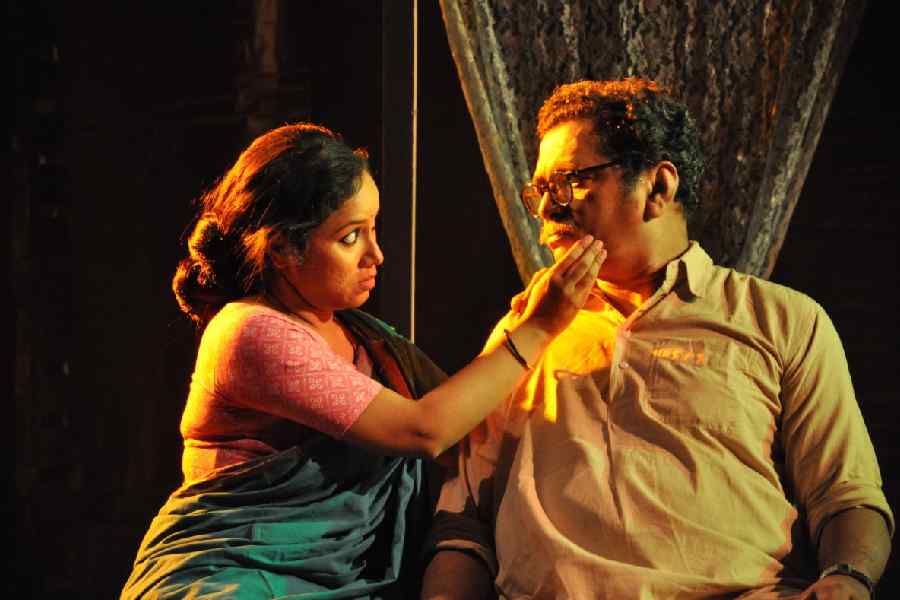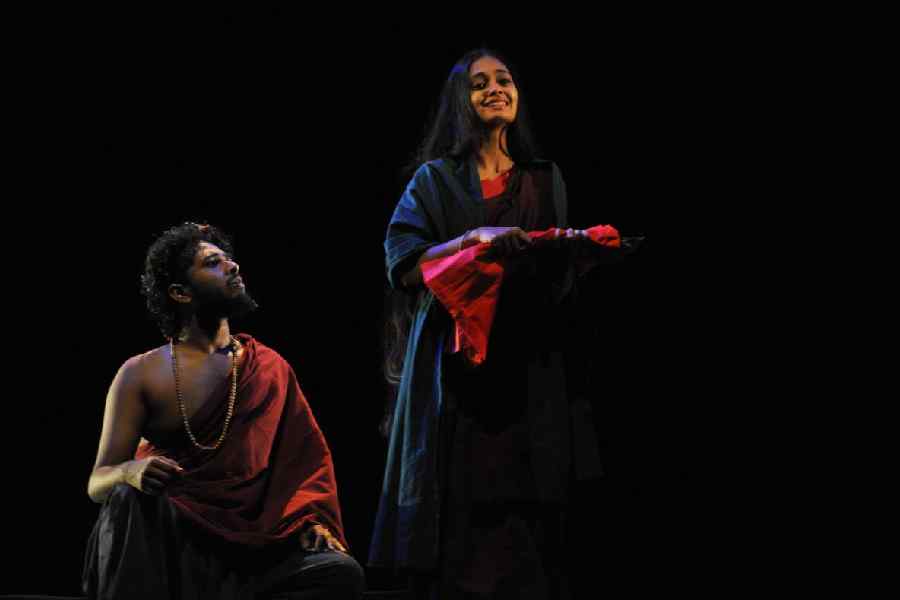Surveillance is suddenly all around us. CCTV footage, webcasting, live-streaming are keywords that define our existence. The State machinery has taken complete control of the digital revolution that promised the democratisation of lives and opportunities. Good old George Orwell had foreseen all this and more in his 1949 novel, 1984. Orwell’s dystopian vision was recently adopted into a full-length Bengali play by Gotroheen Dumdum. Led by Supratim Roy, 2084 (picture, middle), as the production is named, attempts a no-holds-barred exposé of the power structure that engulfs us and will continue to do so.
Staged at Girish Mancha, 2084 rides strongly on Roy’s ability to design a minimalist proscenium space with an emphasis on video projections of news bulletins skilfully produced by the group. An innovative soundtrack, pepped up by selections from Isaac Albéniz’s “Asturias” and Niccolò Paganini’s “Caprice No. 24”, gives 2084 a distinctively international feel.
Poems by Falguni Roy and Rudra Mohammad Shahidullah also assert its anti-Establishment stand. Sumanta Roy and Subhrangsu Mukherjee shoulder the majority of the responsibility in the play by essaying the lead roles; the younger cast, though, leaves a lot to be desired.

A moment from 2084 Dumdum Gotrahin
Mohan Rakesh’s Hindi classic, Ashadh Ka Ek Din (1958), has been freshly adapted by Kasba Arghya as Ekla Ashadh (picture, top). Premiering at the Academy of Fine Arts, the two-hour-long production displays the supreme confidence of the director, Manish Mitra, in dealing with classical themes. Although he keeps to the intent of the original text, he shifts the emphasis of the play to Mallika (Mary Acharya), the heroine, instead of Kalidas and Vilom, the male leads. Ambika (Sima Ghosh), the heroine’s mother, comes in only to accentuate the role of the heroine, who is caught in a dilemma. The subplots were carefully edited. At times, action spoke more than words. Kalidas’s initiation to the court of Ujjain is underlined by the poet’s complete submission to the throne as the queen seizes his writings in exchange for royal patronage. A creative reconstruction of the court scene from Abhijnanasakuntalam as a rehearsal overseen by the playwright himself was craftily inserted to heighten the realisation of Kalidas in the final act. Acharya, Mitra’s protégé, excels as Mallika and Sudip Sanyal, the light designer, takes optimum care to illuminate her facial muscles against a pitch-dark backdrop. Live music, mostly monsoon melodies, enlivens the performance.

A moment from Canvasser Abhash Dakshin Kolkata
Bibhutibhushan Bandyopadhyay’s reputation as an authentic chronicler of Bengali existence in the first half of the 20th century finds a poignant expression in Canvasser (picture, bottom), the latest offering from Abhaash Dakshin Kolkata. Sekhar Samaddar dramatises Bandyopadhyay’s short story on a canvasser of cosmetic products operating along the suburban railway routes with an eye on the minute shifts in prevalent moral codes that defined the life of mess-dwellers rooted in agrarian Bengal. Samaddar, who plays Krishnalal, the hero, as well as directs the production, takes the liberty of extending the timeline by including an episode on Mrinal Sen’s search for real-life actors to etch life-like performances.
Spanning over 90 minutes, Canvasser rests entirely on Samaddar’s acting prowess, supported by Soumita Biswas, playing Golapi, the hero’s love interest. Shampa Das, playing a prostitute’s mother, may try a more rounded portrayal. Abhaash’s over-dependence on video projections may also be reconsidered as it only repeats the ideas explored in Anupam Dasgupta’s art design and the onstage acting.











